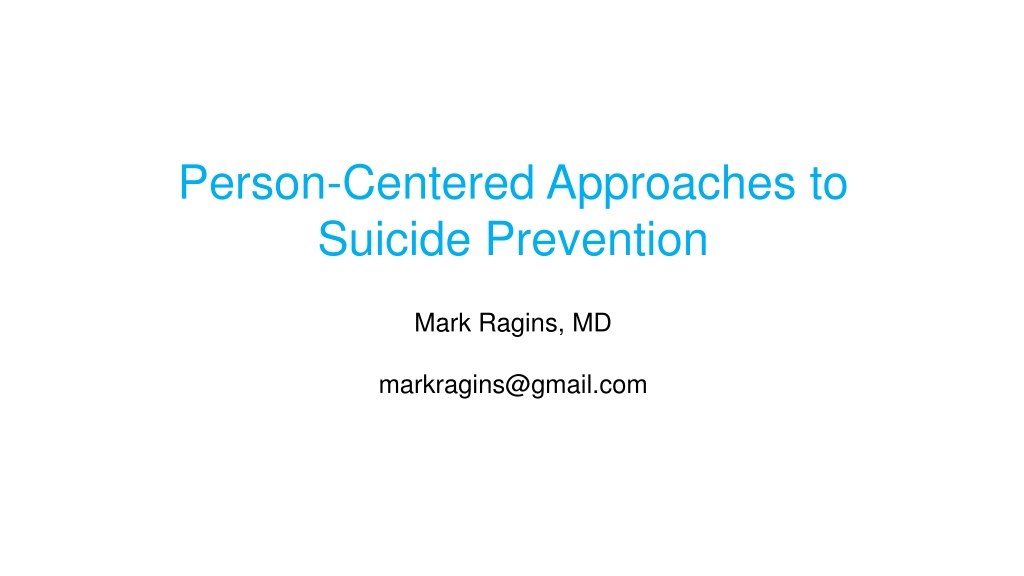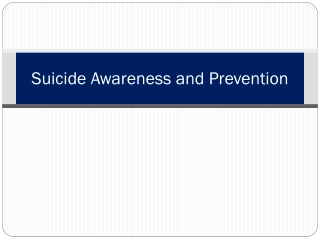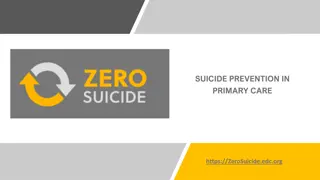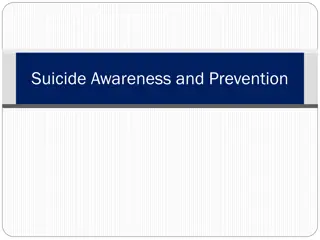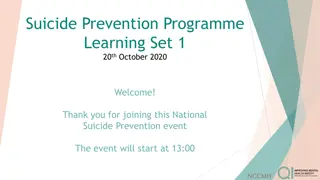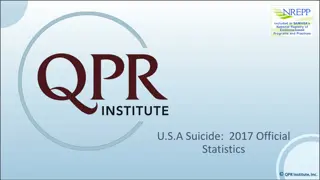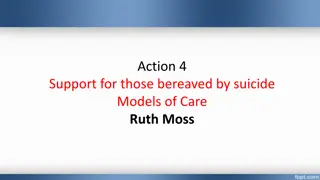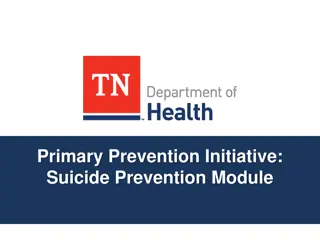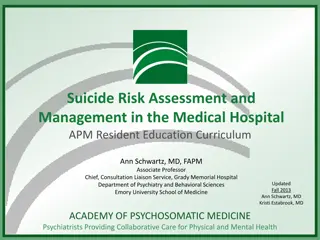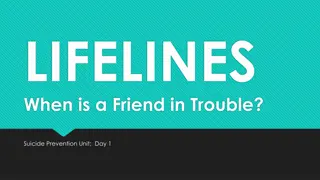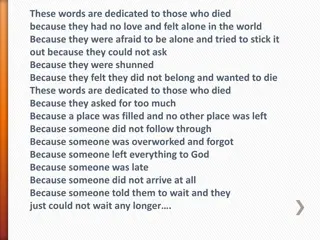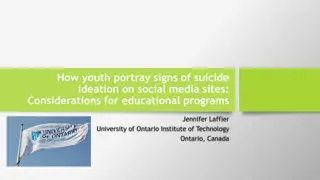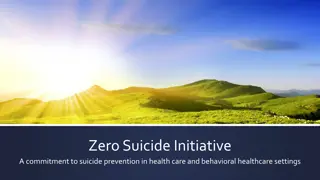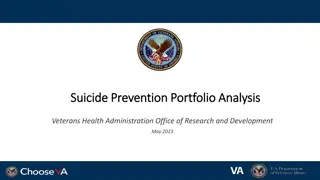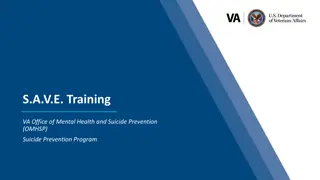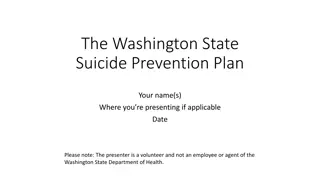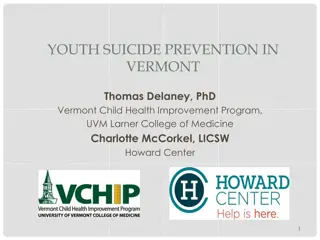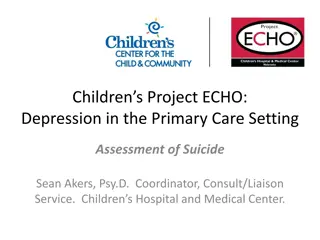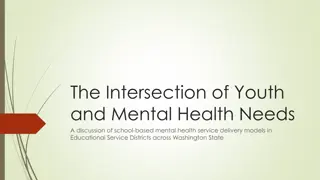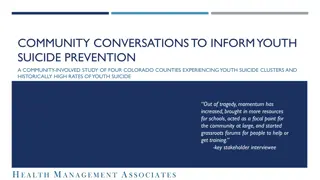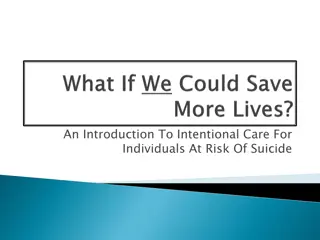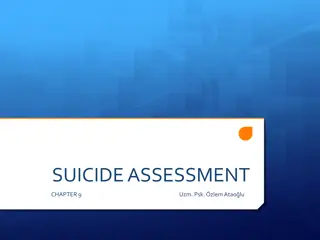Person-Centered Approaches to Suicide Prevention by Mark Ragins, MD
Exploring person-centered approaches to suicide prevention, this content delves into suicide motivations, risk factors, and current paradigms in addressing suicidal thoughts. It emphasizes understanding individuals' unique struggles and needs to provide effective support and intervention strategies.
Download Presentation

Please find below an Image/Link to download the presentation.
The content on the website is provided AS IS for your information and personal use only. It may not be sold, licensed, or shared on other websites without obtaining consent from the author. Download presentation by click this link. If you encounter any issues during the download, it is possible that the publisher has removed the file from their server.
E N D
Presentation Transcript
Person-Centered Approaches to Suicide Prevention Mark Ragins, MD markragins@gmail.com
Washington University demographics of completed suicides vs suicide attempts Male Middle aged Firearms Depression Alcohol or drug abuse often with acute loss, bottomed out Incurable painful condition They had often made told someone, including health and mental health providers, made plans, taken steps (like giving away things)
Suicide motivations lethal : seriously considering or taking action to kill themselves. Their goal is to die. miserable :having overwhelming feelings of some kind that make them feel like they d rather die than go on like this. Their goal is to escape their suffering and death seems like the only option. communicating : using suicide in order to attract attention, communicate to someone else, or get some other needs met. Their goal is to get access to change something in their lives that has been blocked. self-harm : harming themselves in order to relieve unbearable feelings or unbearable numbness, not intending to die. Their goal is to cope, but they re using violent means to soothe themselves. The vast majority of these are not suicide attempts Our responses depend on our assessment. Do we need to confine and control them? Do we need to help them figure out how to find hope and make their lives more bearable so they don t have to die? Do we need to facilitate their communication with other people (might be us)? Do they need to learn other less violent coping skills?
Person-centered risk factors Isolation Hopelessness Powerlessness / helplessness No reason to live Lessened fear of violence and death(e.g. veterans, veterinarians, atheists) Feeling like a burden The Village had very, very low suicide rates, or even attempts even though we did very little suicide assessments, interventions, or hospitalizations because we were working on all these risk factors all the time for everyone.
Currently were coping with inconceivability by medicalizing everyone with suicidal thoughts The most common paradigm today is Thinking about suicide is abnormal. There must be something wrong with you. That something wrong is probably a biochemical mental illness. You should overcome stigma and fears and get treatment so you won t be ill and won t be thinking about suicide anymore. The most controversial statistic in suicide prevention comes from the CDC: 54% of people who kill themselves do not have a known mental illness
What triggers suicide? Is good case-management suicide prevention?
The hardest thing is to have a normal conversation about suicide with someone Common challenges: Inexperience (professional, personal, media) Fear (including, but not only, liability) Inconceivability Accepting our considerable powerlessness This is important because our most common suicide conversations either not talking about suicide, minimizing and dismissing it, or crisis reactions including hospitalization probably harm the majority of people. If we approach people talking about suicide with respectful curiosity we increase our chances of connecting, while also reducing our inexperience, fear, inconceivability, and lack of acceptance of powerlessness.
Motivational Interviewing Stages of Change Deciding to kill yourself is a big life changing decision, presumablya bad decision, with both rational and irrational aspects, that progresses towards taking action. Pre-contemplation Contemplation Planning Action Sustaining
Suicide prevention risk triage and intervention strategy can be linked using MI 1. 2. Suicide thoughts ( contemplation ) decrease hopelessness and isolation Suicidal intent / plan ( planning ) increase ambivalence, increase fear of consequences (of damage done and still lived, of dying, of impact on others) Suicide attempt ( action ) decrease access to lethal means (especially guns, don t leave alone, sometimes involuntary hospitalization) These levels are fluid, changing over a life. Take note of what level they re at now and if that level has increased recently to assess current risk. Notice how the most common suicide risk factors hopelessness, isolation, fearlessness of consequences, and access to lethal means are risk factors precisely because they facilitate moving forwards on this spectrum. Try to avoid referring to hospitals to assess risk. They re too traumatic. Refer to them to decrease access to lethal means for people attempting or nearing attempting suicide for whom you can t make another safety plan. 3.
The vast majority of people who are thinking about suicide won t kill themselves Here are the national yearly statistics: Suicidal thoughts Suicidal plan Suicide attempt Death by suicide This means that statistically 99.6% of people who have suicidal thoughts will not kill themselves. Therefore, the vast majority of people we talk to about suicide do not need their lives to be saved by risk prevention. They need support for whatever they re going through. We need to make sure we re serving those 99.6% well, not just preventing deaths. 9.8 million 2.7 million 1.4 million 44,000 .017% (about 1/6000) 4% 1% .5%
Level 1: suicidal thoughts (contemplation) Respectful curiosity questions: Do you have thoughts about killing yourself sometimes? There is a lower level of thoughts of your own dying, but not killing yourself, or thoughts of falling asleep and not having to wake up. You can ask those questions first to get some positive answers and pave the way. How do those thoughts make you feel? Are they seductive, frightening, both? Do they make you feel like a bad or sick person? Do they feel like they re your thoughts or thoughts that pop into your head unwanted from somewhere or someone? Where or who? If the thoughts have gone on for a long time, how do you cope with them? Befriending them? Exploring them? Worn down by them? Frustrated? Do you believe thoughts that say you should be dead? Why or why not? Does it really make sense to you that things aren t going to get better? How did you convince yourself your problems are hopeless? Do your suicidal thoughts come mostly when you re drinking, or using drugs, or coming down from being drunk or high? Do you only think about suicide when you re feeling irritable, restless, impulsive, or haven t slept for several nights in a row? Do you want to act on thoughts that only come when you re messed up and not yourself? Do you have anyone in your life you can really talk to? How are they responding? Are you afraid you re overburdening them or burning them out? Have you shared your suicidal thoughts with anyone? How did they respond?
Decrease Hopelessness Accept where they re at and start from there together Hope isn t reassurance Hope isn t optimism or cheerfulness Hope goes through despair Never give up on someone and even if they give up on themselves Guide them as we go through this together Try to assess if their hopelessness is chronic and persistent, or intermittent, or new. If possible, create some separation between the events in their lives and their feelings of hopelessness. Hopelessness can be increased acutely with drugs and alcohol, sleeplessness, being upset all of which tend to go down if they can wait it out safely.
Decreasing isolation Are they really connected to a mental health professional? Who else is in their life whose relationship can be enhanced? The other people don t have to be able to connect talking about suicide they just need to be able to help the person not feel so alone. What can they do themselves to decrease isolation? Is isolation a long-standing condition in their life, or something more recent? Reconnecting may be easier than connecting. Do they have some good past social habits or traits that can be re-engaged? Are all of their connections disability-based ? Can they develop some peer or strength-based connections?
Level 2: Suicidal Intent / Plans (planning) Respectful curiosity questions: When you think about suicide, do you think you ll actually do it some day? Why or why not? Are you frightened of killing yourself? What keeps you from killing yourself? Some of your thoughts urge killing yourself and others urge staying alive. What are the staying alive thoughts? How do you try to talk yourself into staying alive? When you think about killing yourself, do you visualize how you d do it or is it more like a wish or desire you d be dead? Have you given any thought as to how you d actually kill yourself? How? Why that way? Have you worked out the details? Have you tried before? With the same plan or have you changed the plan or are you impulsive? Why didn t it work before? Do you think God had anything to do with keeping you alive? If so, do you really think he ll let you die now? Did the past attempt cause harm? What? To who? Would anyone, including a loved pet, miss you or need you to take care of them? Do you think you re a burden and everyone would be relieved if you die and be better off? Have you ever met anyone who was relieved when someone killed themselves? You know yourself. How close to trying again are you? Remember, the attitude in all of these questions is respectful curiosity . Explore with them. Don t attack their beliefs or they re more likely to dig in. Look for thoughts and doubts you can ally with already existing within them. That s using a motivational interviewing approach to increase ambivalence.
Enhancing Fear The vast majority of people are too frightened to try to kill themselves and that likely prevents many suicides. Try to increase their fear without lecturing them or coming off as melodramatic. There s no need to exaggerate because there are plenty of realistic reasons to be fearful of suicide: Pain It might not work Physical damage Guilt feelings Hurting and abandoning other people and pets Effecting your family s legacy Getting locked up in a mental hospital Being looked at as crazy or rejected Encouraging others to kill themselves What happens after-death is unknown God s punishment and Hell
Level 3: Suicide Attempt (action) This level includes people taking actions that directly lead to killing themselves. These actions include preparations (like giving away possessions and pets, writing a note, saying goodbyes, making sure bills are paid) as well as actions (like collecting pills, buying a gun, checking out a local bridge). If you ve started at the lower levels with your questions and proved that you can have a conversation about suicide (without rejecting them, panicking, judging them, minimizing them, or cutting them off) you have a much better chance of them telling you if they re taking actions. You ve earned the right to ask directly and be responded to with honesty. This level is the time to insist on mental health professional evaluations, even over their objections.
Decrease access to lethal means This is where guns become important most attempts with guns will succeed and most using anything else, especially pills, will fail. There are laws that permit us to call police to have their guns removed if they are suicidal. This is where safety plans are important. If the person wants to avoid killing themselves try to create a comprehensive plan to help keep them from being alone and unsafe. Safety plans have largely replaced safety contracts . This is also where psychiatric hospitalization should be considered. Someone may agree to go or not, but either way its likely they will be put on a 72 hour hold because if they changed their minds and decided not to be in the hospital, they wouldn t be allowed to leave. It s not really voluntary. Nonetheless, being as empowering, collaborative, and trauma sensitive as possible can make a huge difference. After all, they are gong to have to take control of their own lives soon.
Small group exercise Everyone in the group tell a story about someone you know (either in or out of work) who has been suicidal and you were somehow involved. After listening to the story briefly discuss: What level was the person at in the story? How did your reaction / intervention match the level they were at? Any ideas from the group of what else you could ve done (in retrospect)?
Long-term suicide issues (sustaining) Most of the people we deal with have histories of some suicidality, often serious and/or ongoing and plenty of risk factors. They need long-term interventions, not just acute interventions. How are they going to: Respond to the crisis interventions they ve been given? Come to terms with having tried to kill themselves to integrate an unacceptable action within themselves? Reconnect to people after having done something inconceivable? Live while being tormented by ongoing suicidal thoughts that wear them down? Reconnect with mental health professionals worried about suicide risk?
Follow-up / Aftercare We all have a tendency to see a suicide assessment and intervention as a completed action especially if we hospitalize them but from their point of view its more likely to be one chapter in their lives. The most common time to complete suicide is in the 2 weeks after a psychiatric hospitalization. If they re going to recover, it will most likely take more than just a suicide prevention intervention. Just getting them back to baseline is a set up for the same crisis to reoccur. Help them do something specific that may improve their life. Referrals and hospitalizations can feel rejecting, so offer to reconnect. Give them your card. Make an outreach call in a few days to check in. They ll appreciate it. Keep hope alive by visualizing and planning a future with them. Help them grow and learn from the crisis: You paid the tuition at the school of hard knocks, you should get the lesson. Don t waste their suffering.
Crisis Can be Traumatizing Crisis Can be Traumatizing So Can Crisis Services So Can Crisis Services The vast majority of people in crisis services have experienced severe trauma in their past that influences how they experience and react to the world, including us. Many people find our crisis services, especially coercive services, to be traumatizing and re-traumatizing, even though that isn t our intent and we re often unaware of the impact we re having. Instead of fighting them to control them, we need to ally with them to reduce their distress and their reactions to it, to help them regain control. Services should be done with them instead of done to them . Trauma informed care is a series of principles and practices that creates an overall service culture and environment that minimizes traumatization and re- traumatization Don t forget resilience informed care : Clients bring strengths and skills gained by overcoming past traumas too. We can work to re-strengthen them instead of re- traumatize them.
Telling stories and really listening to them Established in 2010, Live Through This is a collection of portraits and true stories of suicide attempt survivors across the United States 1.4 million Americans attempted suicide in 2017 (the most recent year for which we have data). Ninety percent of those people will go on to live out the natural course of their lives. Unfortunately, prior to a few years ago, suicide attempt survivors were an almost unilaterally anonymous group millions of people shamed into silence and reduced to statistics, living in constant fear of prejudice and discrimination at home and in the workplace. https://www.youtube.com/watch?v=18vnsyDE- W8#action=share
Out of the Darkness: Out of the Darkness: Suicide Prevention Walks
How does suicide effect the rest of us? Suicides can cause traumatic dissociations for others combined with a stew of emotions (grief, guilt, resentment, helplessness, etc.) Suicide can be contagious making it a more realistic choice for others Suicide can have professional implications (e.g. VA policies, being sued), can stick in our heads altering how we see everyone else, and change administrative policies.
Whos really responsible if someone kills themselves? You have to answer to authorities and to yourself. Dead clients can become a long term burden. Is suicide a personal choice? Are we responsible for our own lives? What if someone is mentally ill or otherwise impaired? Does it matter if we agree with their decision? Is God or fate responsible for life and death? Can we find meaning in their death? If not, do we have enough faith and trust to accept their death? Is their life our responsibility? What ifs , regrets, second guessing. How much power do we really have? Was this a one time preventable event? What are we actually responsible for? We can be responsible for connecting to people, for being hopeful and reasonable, for not putting them into a corner, for working towards supports, BUT NOT for their lives
Small group exercise Return to your small groups Everyone tell a story about how knowing or working with someone who attempted suicide or killed themselves has effected you. How did it effect you? What support would ve helped you? What advice do you have for others working with suicidal people based on your experience? I wonder, as suicide rates continue to climb, and more and more people are impacted, what impact that will have on us as a society.
